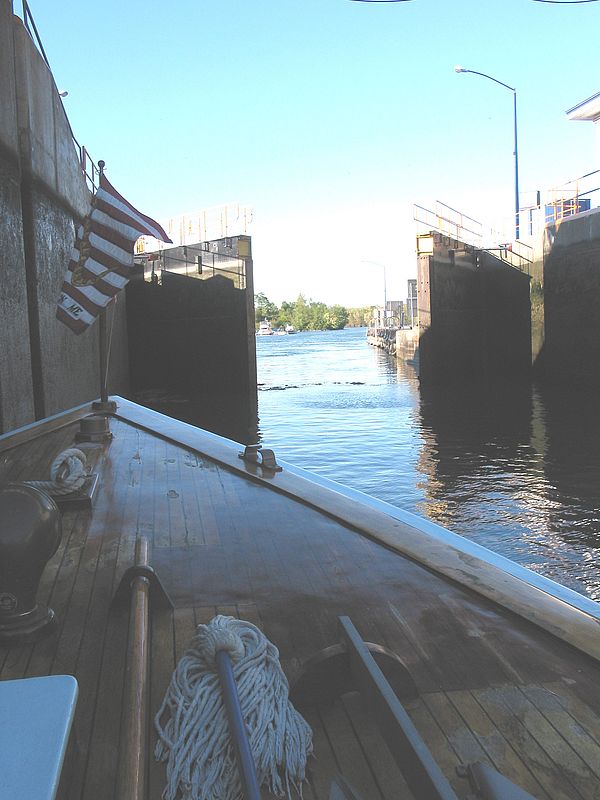When New York Governor Andrew Cuomo was still Attorney General, he weighed in on the side of Michigan when they called for Illinois to sever a century-old Chicago Canal because of the threat that Asian carp would move from the Mississippi River drainage into the Great Lakes drainage. Now, Lake Champlain is threatened by an invasive species, the spiny waterflea, which is found in the Champlain Canal. It will be interesting to see how adamant the Governor is when the threat of invasive species occurs in his own backyard and in a canal system under his authority.
Canals offer species an opportunity to move from one waterbody to another in places other than Lake Champlain too. For example, shipping canals have been cited as the most important gateway for invasive aquatic species to reach inland Germany. In 2005 David Pimental, a biologist at Cornell University, published an article in Environmental Management about the role of the New York State Canal System in spreading invasive species. He estimated that invasive aquatic species were causing $500 million dollars in economic losses each year in New York.
The Champlain Canal connects Lake Champlain directly to the Hudson River system, and indirectly to the Great Lakes by the Erie Canal offering a convenient conduit for invasive species. Of those exotic species whose origin of introduction to Lake Champlain is known, over 60% entered via canals with the majority of those coming through the Champlain Canal. Water chestnut, the scourge of the South Lake, likely came through the canal in the 1940’s. Zebra mussels and white perch made their trip in the early 1990s.
For years there have been calls for the New York State Canal Corps to take concrete steps to limit the possibility of invasive species movement between water bodies. A 2005 report titled Feasibility of Champlain Canal Aquatic Nuisance Species Barrier Options spurred the discussion. At a public meeting in 2008, the Canal Corps heard from numerous voices including the Lake Champlain Committee about the important role the canal plays as a vector for invasive species. We urged them to “focus their efforts on an effective barrier option”.
The Champlain Canal first opened in 1823 promising, and providing, extensive commercial connection between the resources of the North Country and the markets and manufacturers of Montreal and New York. During its heyday in 1890, the canal carried over 1.5 million tons of commercial freight. As recently as 1988, over 250,000 tons of commercial goods still passed through. Since then however, commercial traffic has withered. Today less than one percent of the 1988 tonnage transits the canal. The lock closest to Lake Champlain served fewer than 1,100 boats last summer, 90 percent of them pleasure craft.
By contrast, the Chicago Sanitary Canal, which Governor Cuomo once called for closing, thrives economically. The busiest lock on the Chicago Canal transits 160,000 tons of goods each week! Cost estimates for closing that canal range from $70 million to $235 million per year in lost economic productivity.
Closing a canal presents distinct engineering and logistical challenges. Alternative means of transport around defunct locks must be provided. Along the Trent-Severn Canal in Ontario a short marine railway provided a link between locks. On the Fox River in Wisconsin a lock was closed to stop sea lamprey and a boat lift is being considered in its place. After closure of a lock, water must still be supplied for locks that remain open. In some cases, locking mechanisms might need to be redesigned. While these challenges are significant, they are not insurmountable.
Meanwhile, the cost of allowing invasive species into the lake is considerable. Zebra mussels necessitated investments by water suppliers to prevent them from clogging intakes. The cost to marinas, water treatment facilities and fish hatcheries of treating zebra mussels in Lake Champlain exceeds $65,000 per year. Almost $10 million has been spent to control water chestnut in Lake Champlain since 1982.
Even if actions can’t be taken in time to stop spiny waterflea, there are other invaders on the horizon. Round goby, a fish species, and Quagga mussels, a close relative of zebra mussels that live in deeper water, are in the Erie Canal system and making their way eastward. The highly invasive plant hydrilla has recently been found in Seneca Lake and is likely to reach the canals soon. How many more invasive species will Lake Champlain have to endure before the vital link of the Champlain Canal is finally addressed?
Governor Cuomo once called for drastic measures to reduce the risk of Asian carp reaching the Great Lakes. He should once again do so to reduce the risk of a host of invasive species from reaching Lake Champlain.
